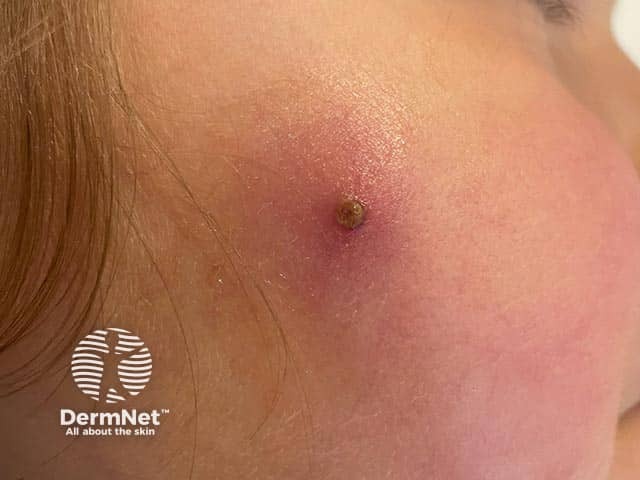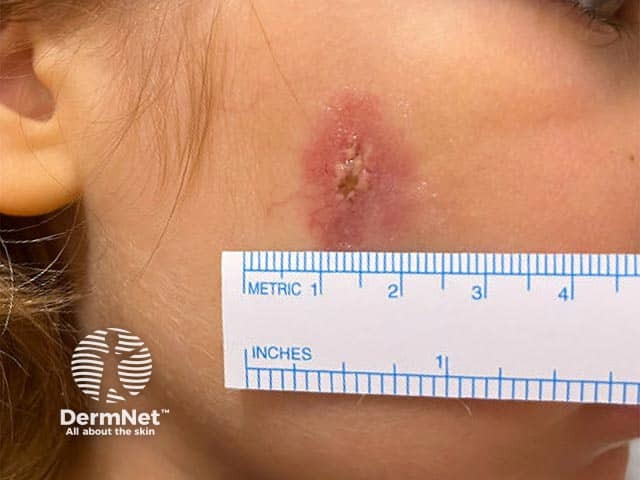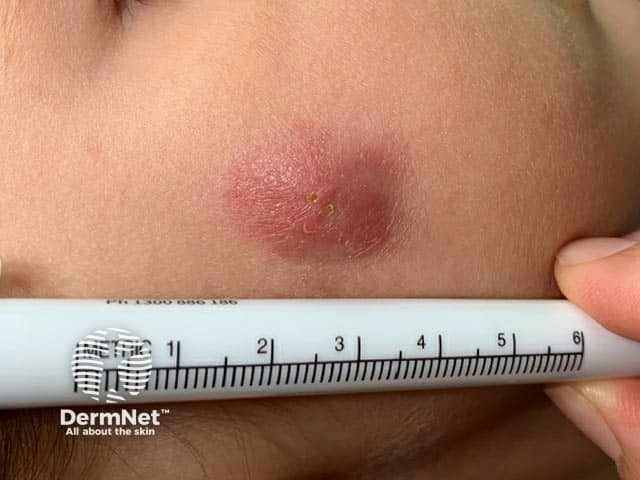Main menu
Common skin conditions

NEWS
Join DermNet PRO
Read more
Quick links
Authors: Dr Anne-Marie Aubin, Resident; Dr Kirsty Wark, Dermatology advanced trainee; Dr John Relic, Consultant dermatologist, John Hunter Hospital, Australia (2023)
Reviewing dermatologist: Dr Ian Coulson
Edited by the DermNet content department
Introduction Demographics Causes Clinical features Variation in skin types Complications Diagnosis Differential diagnoses Treatment Prevention Outcome
Idiopathic facial aseptic granuloma (IFAG) is a rare, painless, self-limiting, solitary nodule which affects children.
It is reminiscent of an acne nodule and usually heals without scarring. It typically presents on the cheek or eyelids as a red-violaceous papule or nodule. Multiple lesions are uncommon.

Violaceous plaque on the cheek due to idiopathic facial aseptic granuloma

Violaceous indurated plaque with central ulceration in idiopathic facial aseptic granuloma

Violaceous plaque with some overlying crusting due to idiopathic facial aseptic granuloma

Indurated plaque over the cheek in a child with idiopathic facial aseptic granuloma
Idiopathic facial aseptic granuloma (IFAG) occurs exclusively in young children and adolescents, with a mean age of 4 years at presentation.
It appears to be twice as common in females than in males.
The pathogenesis of IFAG remains unclear but is thought to be a type of childhood granulomatous rosacea. This theory originates from its association with chalazions, telangiectasias, and localisation to the eyelids, fitting the rosacea spectrum.
Other theories include a reactive process to insect bites or trauma, or an embryonic remnant.
No clear risk factors or associated clinical features have been described.
Further research is needed to describe features of idiopathic facial aseptic granuloma in darker Fitzpatrick skin phototypes and races.
Complications of idiopathic facial aseptic granuloma (IFAG) are rare.
However, IFAG increases the risk of developing rosacea in the future, particularly ocular rosacea. Thus, complications of ocular rosacea may occur, such as blepharitis, episcleritis, keratoconjunctivitis, and (rarely) corneal ulcers.
Idiopathic facial aseptic granuloma (IFAG) is often diagnosed clinically without any investigations.
On examination, the mass is non-tender, soft, compressible, and lacks comedones. The tent sign (angulated shape of the lesion from calcification) can be used to differentiate IFAG from pilomatricoma (which calcifies). Dermoscopy may reveal an erythematous base with nonbranching linear blood vessels, a whitish halo, and follicular plugs.
Bacterial, viral, and fungal cultures are typically negative. Ultrasonography of IFAG will show a well-demarcated, hypoechoic oval lesion without calcification or vascularity.
Although diagnosis is mostly clinical, a skin biopsy may be very useful. Histopathology may show a chronic dermal lymphohistiocytic infiltrate with foreign body-type giant cells.
A conservative approach is preferred, as idiopathic facial aseptic granuloma (IFAG) is generally self-limiting.
Topical (metronidazole) and systemic antibiotics (clarithromycin, erythromycin, metronidazole, or doxycycline) have proven effective in some cases but optimal treatment duration is yet to be established. Tetracyclines are relatively contraindicated in children under 8 as they may stain unerupted teeth.
Low-dose systemic retinoids are emerging as safe and effective for IFAG.
Few cases require surgical excision. This is not recommended as a first-line treatment due to the high proportion of cases which resolve spontaneously.
There are no known risk factors or ways to prevent idiopathic facial aseptic granuloma.
Prognosis is favourable, and most lesions resolve spontaneously without scarring within a year. There may be residual hyperpigmentation as the lesion heals.